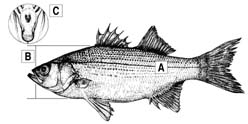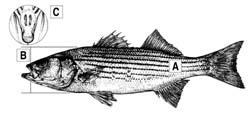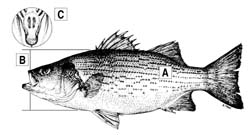Message Board

If you liked the information you found on this fishing blog, you will find out much more at my new site:
Join our Striped Bass Message Board
Please check out the forum, and sign up.
Fresh water fishing information! Striped Bass, Bass, Catfish, Fishing Knots, and More.....

 Gamakatsu Wide Gap 6/0 Shiner Hook |
Among the most impressive learning experiences for someone like me, who has been writing about catch-and-release fishing for more than 20 years, was hands-on instruction in how easily and effectively hooks can be removed from a fish's gullet.
We traveled last spring to the Orlando, Florida, area to shoot television footage of fishing for big bass on Lake Toho, using shiners, the time-honored approach for huge bass from this heavily fished lake.
That Toho continues as one of the best places in North America for bass of 10 pounds is, in part, a tribute to catch and release. Guide Robert "Jamie" Jackson, Freelancer Guide Service, has been guiding on the lake for more than 20 years. Of the 40 or so bass we caught in two days, at least one fourth had obviously been hooked before. "A little on the low side," Jackson said. "Some days, half the fish we catch have been caught before. We often catch the same fish again and again from some spots."
| |
Fishing shiners is an art that we'll try to cover next spring. Primary to my point here, though, the first fish I hooked (about 6 pounds) had the wide-gap 6/0 Gamakatsu shiner hook just about down the gullet, with only the eye of the hook showing. I gave Jackson an "oh-oh" look, but he just calmly took the fish and unceremoniously popped the hook free, held the fish up for the camera, and released it:
Basically, the technique is akin to some of the instruction we offered in an article by Ralph Manns (and In-Fisherman) in February 2002, "The Deep Hook Dilemma."
(1) With the hook in the gullet, note which side of the fish's mouth the hook shank is toward. Note: For illustration sake, the line is eliminated here in steps 2 through 5. In reality, the line stays connected as this technique is performed.
 | ||
(2) With a finger or two, reach in through the last gill arch on that side of the fish and push and pull down on the hookeye so the hook turns and . . .
 | ||
(3) rolls out below the gill toward the side of the fish. At that point, amazingly, the hook, barb and all, almost always pops free from its hold in the fish's gullet.
 | ||
(4) Reach into the fish's mouth and grip the bend in the hook (which is now up) and . . .
 | |
(5) lift it free. If the fish's mouth is too small to reach in with your hand, use a needle-nose pliers to grip the hook bend.
 | ||
Jackson also emphasized, as we also noted in the earlier article, how resilient a fish's gills actually are, far from being the fragile organs often suggest by some sources. And the occasional bleeding fish? Does it have to be kept? Jackson: "Just get the fish back into the water as soon as possible and, more often than not, the bleeding stops--at least we've caught these fish again and again.
The technique also works superbly on walleyes, smallmouths, and other fish, usually taken on smaller hooks, often salmon-style hooks. In a sidebar entitled "Hook Removal Walleye Style" in the February article, we related Mike Herrick's experiences in removing hooks by working through the gills, in much the same way Jackson works on largemouth bass.
I used Herrick's technique this past spring and summer. It works every bit as well as Jackson's approach with largemouths. Really, it 's possible to remove most hooks in a fish's gullet, as Herrick instructed in our February article:
* Look down the throat to check the hook position. If it's set in the throat or gullet--or it's out of sight--give a gentle pull on the line and the hook eye usually emerges.
* Check which side the hook shank is on. Then open the gill flap and, with small walleyes, use a forceps to grip the hook shank just below the eye. Roll the hook out toward the gill and side of the body of the fish and the hook and barb pop free from the lining of the gullet.
Simple as that. Really, it's amazing. With a bit of practice, you'll be killing fewer fish--indeed, almost no fish that you plan to release.
Once these techniques become much more widely used, we'll have taken another large step forward in helping to sustain better fishing based on a commitment to release some fish so they can be caught again.

A. Does not have a tooth patch near the midline towards the back of the tongue.
B. Stripes distinct, broken above anal fin.
C. Dorsal fins joined.
D. Color - silvery yellow
 White Bass
White Bass A. Has one tooth patch near the midline towards the back of the tongue.
B. Body deep, more than 1/3 length.
C. Stripes faint, only one extends to tail.
 Striped Bass
Striped BassA. Has two, distinct tooth patches near the midline towards the back of the tongue.
B. Body slender, less than 1/3 length.
C. Stripes distinct, several extend to tail.
 Hybrid Striped Bass
Hybrid Striped Bass A. Has two, distinct tooth patches near the midline towards the back of the tongue.
B. Body deep, more than 1/3 length.
C. Stripes distinct, usually broken, several extend to tail.